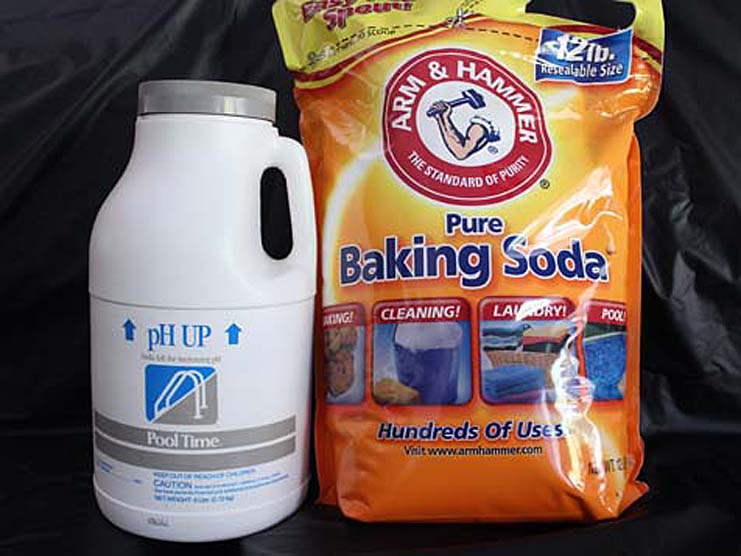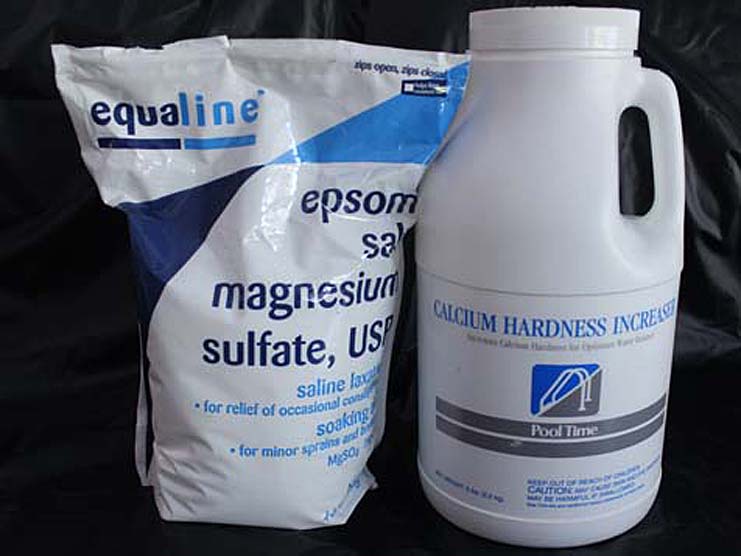Adjusting Water Chemistry
In some cases you will not need to adjust the water chemistry in a freshwater aquarium. Often the water that comes from the tap is adequate for the fish and plants you may desire to keep. If the fish and plants you want to keep require different water chemistry than what you have coming out of your faucet, you will need to add or remove major trace elements.
Whenever you add chemicals to the to adjust the chemistry, first dilute it in a cup of water and then slowly pour into the aquarium in a high flow area to help disperse it quickly. Dumping raw chemicals in the tank can damage live plants and kill beneficial bacteria. Water chemistry should always be adjusted slowly over the course of several days or weeks if a major change is required. Keep a log of what you add to the water to adjust the chemistry, so you will know how much to add to new water when making water changes.
Large quick adjustments of the water chemistry can cause a condition in fish known as osmotic shock and/or pH shock. Osmotic and pH shock can kill fish in three days or less. The symptoms include; resting on the bottom of the tank, and abnormal heavy respiration. Fish that display these symptoms can be saved by returning them to aquarium conditions they were acclimated to before making the adjustment. It can take several days for a fish to recover from osmotic shock, so it may be necessary to use an isolation container to protect the fish from other inhabitants.

pH/alkalinity can be adjusted up by adding sodium bicarbonate (baking soda), sodium carbonate (soda ash, washing soda, pool pH increaser), or a pH increaser from many of the aquarium product manufacturers. For most freshwater aquarium sodium bicarbonate is the primary chemical used to increase the pH. As long as the target pH is not greater than 7.8, sodium bicarbonate would be the chemical of choice. If you are going to keep Lake Malawi, or Lake Tanganyika fish which require very high pH range, sodium carbonate would be the primary chemical of choice. When using sodium carbonate, use only a quarter of the amount you would use with sodium bicarbonate as it has a greater effect on pH, and will help maintain a higher than 7.8 pH.
Adding 1 teaspoon of sodium bicarbonate per 10 gallons (40 liters) will raise the TDS approximately 90 ppm. Since nitrate is an acid, the pH will vary depending on how much nitrate is in the aquarium.
Several aquarium product manufacturers make pH increasers with different formulated ratios of chemicals, depending on the type of freshwater fish you are trying to keep. The chemical ratios in these products are used to target a specific pH. Follow the manufacturer's instructions on how much to add.
The pH can be lowered by adding sodium biphosphate, sodium bisulfate, or a pH decreaser from many of the aquarium product manufacturers, but it is not the recommended method. Using chemicals to lower the pH can have an undesirable effect on the aquarium ecosystem. Higher than desirable pH is more often the result of hard alkaline water, and using soft water in the aquarium will normally solve the issue. Using soft water and sphagnum peat moss is the choice of many advanced soft water fish breeders that need the acid water conditions for optimal reproduction.
Fish that come from soft acidic water conditions in the wild will often benefit from the same conditions in the aquarium. Often fish that come from soft acidic water will be easier to breed and have higher fertility rate if provided with similar water in the aquarium. Some examples of soft acidic water conditions can be found in the Rio Negro in Brazil, Rio Orinoco in Colombia and Venezuela, and Lake Mai-Ndombe in Congo. These bodies of water often have a pH of 4.0 to 5.5 and almost no measurable hardness.

When you make your water soft, you are not just trying to remove calcium and magnesium, but also alkalinity to reduce the TDS. There are a few ways you can make your tap water soft, reverse osmosis (RO) filtration, deionization (DI) filtration, and ion exchanger. The goal of using a water softener is ultimately to reduce the TDS. A TDSmeter is good tool to have on hand to determine how soft the water is after it has been filtered and also lets you know when your filter needs maintenance.
Reverse osmosis filtration systems are connected to your tap water faucet or teed into the cold water supply. Cold water is passed through a micron filter, carbon filter and thin film composite (TFC) membrane. The TFC membrane removes about 95% of the TDS from the tap water. Typically, for every four gallons (15.2 l) of water that passes through the filter only one gallon (3.8 l) is collected. The unit has two lines coming out, one for wastewater, and the other goes to a collection container. Many hobbyist use a plastic trash can as a collection container. When you set up a RO system for the first time, check the TDS of the collection water. Note the TDS reading and then check periodically. When the TDS reading is higher than desirable, it is then time to change the membrane. The carbon filter and micron filter should be changed every six months.
Deionization filtration units are sold by some aquarium product manufacturers. They use a positive and a negatively charged resin to remove elements from the water. These type of filters can get exhausted very quickly, especially if you have very hard tap water. Many aquarist use DI filtration systems after a RO filtration system to remove the final dissolved solids.
Ion exchangers are available by some aquarium product manufacturers, often called water softening pillows, but they exchange calcium and magnesium for salt (sodium chloride), and do not give the ultimate desired result of lower TDS. Water softening pillows are recharged by soaking it in saltwater. Whole house water softeners are also an example of an ion exchanger that also is recharged with salt.
For aquariums 10 gallons (38 l) or less, store bought distilled water may be another solution to consider. Distilled water has no hardness and is excellent for hatching eggs of soft water dwarf cichlids.
Many species of freshwater fish that come from hard and alkaline water conditions will do much better if you supply the same water chemistry in the aquarium. Fish that have evolved in these conditions will often become susceptible to bacterial infections if the same conditions are not provided in the aquarium. Often freshwater fish that some hobbyist have label as “hard to keep,” is do to not providing the proper hardness and alkalinity. Fish that come from Lake Malawi, Lake Tanganyika, Lake Victoria, Caribbean/Gulf Coast side of North, Central, and South America, will often benefit from adjusting the hardness.
How much you will need to adjust the hardness will be directly related to the hardness you are starting with from the source water. Local municipal water suppliers will often publish water chemistry analysis reports on the internet that you can view. These reports will show how many ppm of the elements in the water make up the TDS. You should also test your source water and then adjust accordingly.

The two main elements used to make water hard are calcium and magnesium. Beware that calcium and magnesium do not evaporate and should normally only be replaced when doing a water change. Top off water does not need additional supplementation unless you need to raise the hardness level of the aquarium.
There are several ways you can add calcium to the water. Calcium chloride (Pool Calcium Hardness Increaser, Kent's Marine Aquarium Turbo Calcium, Dow Flake) is a dry chemical, when added to water heats up as it dissolves. It should always be dissolved in a container outside the aquarium before being added. You should keep a log of how much calcium chloride you are adding to the aquarium, and how much it raised the TDS or GH. You can use the information you gather in determining how much you need to add to the aquarium when doing water changes.
Other sources of calcium that can be used are liquid calcium marketed to marine aquarium hobbyist by manufacturers. Liquid calcium is not as concentrated as calcium chloride, so you will have to use more to reach the desired target.
Adding 1 teaspoon of calcium chloride per 10 gallons (40 liters) will raise the TDS approximately 100 ppm
Magnesium can be increased by adding magnesium sulfate (epsom salt) or magnesium chloride. Magnesium levels will need to be increased if you notice calcium precipitating out of solution. Calcium and carbonate can combine and fall out of solution when magnesium levels are too low. This can cause the pH and hardness to drop. Magnesium chloride is the preferred chemical to use to raise the magnesium level, but epsom salt can also be used.
Adding 1 teaspoon of magnesium chloride per 10 gallons (40 liters) will raise the TDS approximately 70 ppm.
Some aquarium product manufacturers make pre-mixed salts for increasing hardness. Seachem makes a “Cichlid Lake Salt” that is a good product for those hobbyist that are trying to keep fish that come from Lake Malawi, Lake Tanganyika, and Lake Victoria. Seachem's “American Cichlid Salt” can be used for livebearers also, like mollies, platies, swordtails, variatus, and guppies. Kent Marine also makes some products to help raise hardness in freshwater aquariums.